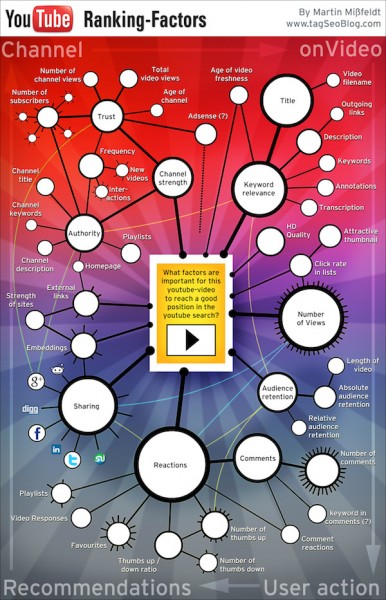General Video SEO Tips
I get this question a lot, and the short answer is that Youtube videos are ranked according to social signals. Google takes into account the number of views, the channel’s frequency of posting, audience retention metrics etc. This infographic by Martin Mibfeldt explains it very well:

Hence, in order to ranked well with your video content I suggest you take into account the following:
– Encourage users to comment, subscribe and like your videos
– Post videos frequently
– Promote your videos using social media
– Respond to every comment if it warrants it
– Invest in high production quality
– SEO titles and descriptions very well
– Add automatic transcriptions for your top videos and, finally
– Link to strong content on your site or elsewhere to connect your videos to great sources of information
Different Video SEO Playbooks
Experts have a wide variety of opinions about video ranking. According to Moz, tags and embeds are two of the most important factors in video SEO:
The third ranking factor on the content side is your tags. You want at least 10 tags. You want them to be keywords, you want to do your keyword research, and you want to make sure that they’re relevant for the video. Something that’s weird about YouTube that’s a little different than Google is that you can have a video that’s all about something, and if you don’t use that keyword in there, it doesn’t really do the semantic matching for you. So, you could have a video that’s all about something, but if you don’t spell it the right way or if you don’t use the plural version versus the singular version, then YouTube won’t even rank it. So you need to make sure, at least until Google gets better at it, that you put those tags in there that have both plural and singular. Do your keyword research. Again, make sure that you understand, what are people looking for that are going to need to watch this video.
Fourth is embeds. That’s going to be people who want to embed the video on their site. Also included is you embedding it on your site or blog. So, if you think about creating your video, you don’t want to just leave it on YouTube. You want to then go and take that and embed it somewhere. Also, you have the ability to turn on or off the embed feature. Now, you have to kind of weigh that out in terms of, maybe you don’t want people to embed it. But the more people that embed it, the better it’s going to rank. So, you kind of have to say, is there a specific reason why I don’t want it embedded on other people’s sites? If there is, then you can turn it off. But I suggest turning it on, and letting bloggers, letting people embed that right onto their own sites. You’re going to see that your rankings will raise as people embed those videos onto their sites.
QuickSprout highlights audience retention as a key factor:
Another very important thing for YouTube SEO is audience retention. This is how long people tend to watch your video. All right, so this is your average view duration. This is how much of the video people watch, and the higher the better. If someone watches the first ten seconds of your video and clicks away, that’s not very YouTube SEO friendly.
And Backlinko has a nice tutorial on finding video keywords:
Your goal is to find keywords that have YouTube results on the first page of Google. These are called, “Video Keywords”. Unlike a normal SERP with 10 webpage results, with Video Keywords, Google reserves a good chunk of the first page for video results… if you optimize for Video Keywords, you’ll also get targeted traffic to your video directly from Google’s first page.
Measurement is Crucial to Maintain Rankings

Video production doesn’t have to be expensive to become highly effective. With moderate effort you can rank your videos in Youtube, Google and other platforms while still respecting a conservative budget. Video SEO is still in its infancy but its getting more complex with every Google update. However, competition is light on this turf so there’s still a lot of traffic to be gained using video channels.
Become Hispanic Ready and Multiply your Results
Read multiple guides, and integrate these ranking social signals into your business model and community engagement practices in order to increase your exposure and position your website as a top video content provider. Then multiply your traffic using the following additional tips:
– Translate your video into Spanish and upload it to YouTube, you can also create a dedicated Spanish channel and have it maintained by interns or Fiverr contractors.
– Cut your videos into pieces and distribute them via Twitter’s Vine.
– Ask your audience which videos they will like to see, measure this and produce accordingly to maximize share after each post.
– Become a micro authority on each subject. Don’t just post a how to video about guitar playing, but post multiple videos on tips and techniques.
– Link to your translations in the description field of each video. Eg. “This video is also available in Spanish”. This sets you apart as a global authority.
